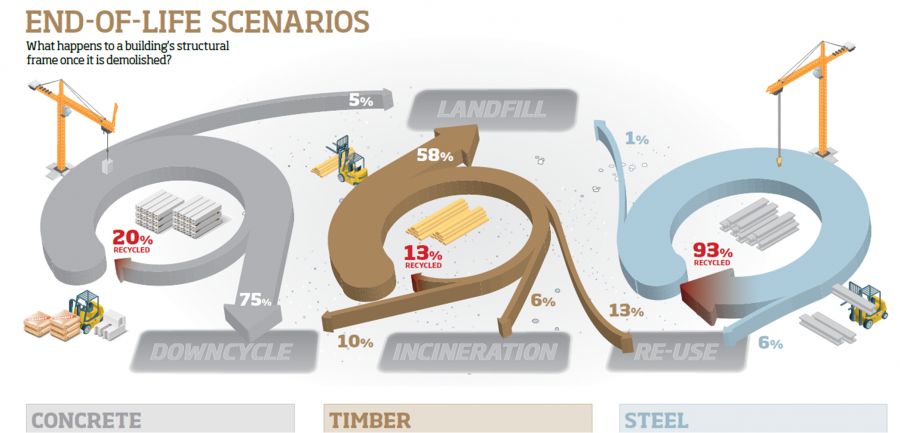Rethinking Steel: Circular Economy and Low-Carbon Innovation in Construction
Discover how circularity and innovation in steel production can cut CO₂ emissions and drive a greener, more sustainable construction industry.
CIRCULARITY
5/8/20243 min read


Steel is essential to infrastructure, mobility, and energy systems—but traditional production is one of the largest sources of industrial CO₂ emissions. By embracing circularity and low-carbon innovation, the construction industry can unlock a greener and more sustainable future.
Why Circularity Matters
Circularity goes beyond simply recycling. It’s about designing products and systems in a way that minimizes waste and maximizes resource efficiency. For the steel industry, this means rethinking how steel is manufactured, used in buildings, maintained, and recovered at the end of its life.
Circular steel systems can help reduce demand for virgin raw materials, lower emissions, and reduce dependency on imports. Moreover, by extending the life of steel products and improving end-of-life recovery, we can optimize the entire lifecycle of construction materials, aligning the sector with environmental, economic, and social sustainability goals.
Repair and Maintenance: Prolonging Structural Lifespan
A key pillar of circularity is extending the service life of steel components. Many steel structures, when properly maintained, can last significantly longer than initially expected. Technologies such as corrosion protection systems, strengthening techniques, and advanced coatings allow for in-situ repairs that delay the need for replacement.
This approach helps reduce embodied carbon emissions and prevents unnecessary demolition—especially in bridges, industrial buildings, and infrastructure projects.
Reuse: Unlocking New Potential
Steel has a unique advantage: it doesn’t degrade in quality over time. If disassembled carefully, steel components from existing buildings can be reused in new constructions. This avoids the need for re-melting and significantly reduces carbon emissions.
However, barriers remain. These include inconsistent building documentation, regulatory gaps, lack of standards for reused elements, and cost-related issues. To overcome this, we need more modular design, improved digital tracking (e.g., material passports), and clearer certification procedures to ensure safety and compliance.
Recycling and Downcycling: Widening the Loop
Europe already leads in steel recycling, with about 50% of EU steel production coming from scrap via electric arc furnaces (EAFs). These processes emit far less CO₂ than traditional blast furnace production and make efficient use of secondary raw materials.
Nonetheless, recycling isn't infinite. Over multiple cycles, steel can become contaminated with other metals or alloys, compromising quality—a phenomenon known as downcycling. Addressing this challenge requires improved material sorting, better alloy separation technologies, and strategies to maintain high-grade steel properties over time.
Decarbonization and Circularity Must Go Hand in Hand
Even with perfect recycling, global demand for steel will continue to rise, especially in developing regions. That’s why circularity alone won’t be enough. It must be coupled with radical innovation in primary steel production, such as hydrogen-based reduction or carbon capture and storage.
Together, these two strategies—cleaner production and smarter use—can drastically reduce the environmental impact of steel.
Policy and Industry Alignment
To accelerate this transformation, supportive policies and industry standards are essential. These include:
Incentives for reuse and modular construction
Mandatory lifecycle assessments for buildings
Clearer standards for recycled and reused steel components
Digital tools for tracking materials across projects
Public procurement criteria favoring low-carbon, circular materials
Moreover, collaboration across the value chain—from steel producers to architects and contractors—is crucial to translate innovation into practice.
Toward a New Construction Paradigm
TIMELESS and similar research initiatives are pushing the boundaries of what’s possible in sustainable steel design. By integrating high-performance materials, modular construction techniques, and smart monitoring technologies, the construction sector can adopt more adaptive, reversible, and efficient building systems.
The future of steel is not just strong—it must also be circular, low-carbon, and future-ready.
TIMELESS Contribution: Redefining Structural Design for a Sustainable Future
The TIMELESS project directly addresses one of the most urgent challenges of our time: how to build safer, more sustainable structures in a world of increasing environmental and social demands. While traditional construction practices rely on outdated models that tolerate damage and require extensive post-event repair or demolition, TIMELESS proposes a radical shift: from repairability to full reversibility and reusability.
By integrating advanced materials such as High Strength Steels (HSS), Fe-based Shape Memory Alloys (SMA-steel), and novel friction joint systems, TIMELESS enables the design of steel structures that remain undamaged under severe events, can self-realign after disruptions, and allow complete disassembly and reuse. These innovations support the principles of Design for Disassembly (DfD) and circular economy, offering a viable path to drastically reduce emissions in the use phase—an area where the construction sector has traditionally lagged behind.
